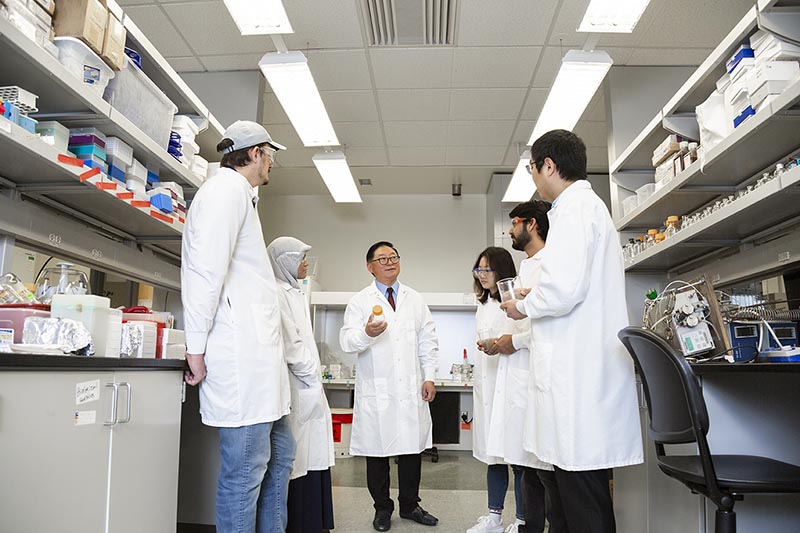
Lignin jet fuel offers potential 100% drop-in SAF solution
In 2019, carbon emissions from the aviation industry reached nearly 1 gigatonne (Gt) or 2.8% of global carbon dioxide (CO2) released from fossil fuel combustion. Covid-19 has had a significant impact on air travel over the past couple of years. As the skies fill up again, we need to double down on our efforts to decarbonise air transportation. Battery electrification and hydrogen fuel cell technologies, viewed by many as the silver bullet for decarbonising road transport, are unlikely solutions for medium and long-haul flights—which encompass 73% of aviation CO2 emissions.
It is widely accepted that the aviation industry’s contribution to global warming goes well beyond CO2. Some scientists believe aircraft contrails, the feathery white lines that decorate the sky long after an aeroplane has disappeared, deliver an even more significant environmental impact than CO2. Contrails consist of water vapour that condenses as ice onto soot particles emitted from aircraft engines and can have a long-lasting warming effect as heat is trapped in the atmosphere. It is still unclear the impact hydrogen turbine propulsion will have on contrail formation.
When it comes to contrails, the finger has been pointed squarely at aromatics in jet fuel. Fuels with a higher concentration of aromatics emit higher particulate emissions. The slow-burning nature of aromatics has been associated with increased soot emissions, as well as contrails.
An obvious solution is to reduce aromatics content in jet fuels. However undesirable, aromatics address key safety issues in today’s jet fuels—including the ability to swell the “O-rings”, to seal metal-to-metal joints, and provide jet fuel with the density needed for current specifications. Current standards mandate an upper limit on aromatic content of 25% by volume, but also a minimum requirement of 8% due to its critical role in the swell of sealings in the fuel system.
A report published by research and consultancy company, CE Delft, in February 2022 on the Potential for reducing aviation non-CO2 emissions through cleaner jet fuel, has called for greater efforts to reduce the non-CO2 impact of aviation. The Dutch research, which included interviews with industry experts and parties involved in the production and supply chain of jet fuel, explores three options for controlling aromatics content, including within the ReFuelEU Aviation proposal. ReFuelEU Aviation is a comprehensive policy proposal containing the necessary foundations for long-term investment security in sustainable aviation fuel (SAF). The ReFuelEU proposal includes the mandatory blending of SAFs in fuel supplied to aircraft departing from European airports.
Sustainable aviation fuel offers the ability to significantly reduce carbon intensity and, equally importantly, lower aromatics and contrail formation. Approved SAF pathways are currently limited to a 50% blend with conventional fossil-based jet fuel, meaning the aromatics issue is not completely resolved. An increase in refinery costs (associated with lowering aromatics concentration) could also encourage refiners to increase the blend of aromatics in conventional jet fuel to the applicable limit as a cost reduction measure—thus negating the impact of blending with SAFs, according to the CE Delft report.

A research paper published in the journal Fuel on April 15, 2022, detailed a new, experimental plant-based jet fuel blend based on lignin, an organic polymer that makes plants tough and woody. A patented process converts lignin from agricultural waste into bio-based lignin jet fuel (LJF). The authors highlighted the potential use of LJF as a blend component for a 100% drop-in SAF solution.
The research included contributions from researchers at several institutions in the United States and Canada including the University of Dayton, Washington State University, Pacific Northwest National Laboratory, and Natural Resources Canada.
Lignin jet fuel is primarily composed of cycloalkane hydrocarbons—C6-C18 mono-, di-, and tri-cycloalkanes. The research team analysed fuel properties specific to jet engine operation, citing an opportunity to improve fuel performance, efficiency, density, and reduce emissions. LJF also has the advantages of leveraging existing infrastructure and the ability to dispense with aromatics.
Qualification of a SAF can be a long and arduous procedure. The technical evaluation for alternative jet fuels is defined in ASTM D4054, before a new fuel can be added to the drop-in fuel specification ASTM D7566. Even after completing the process, which can take several years and require large volumes of fuel, SAF can only be blended to 50% currently. A recently developed ASTM D4054 Fast Track program allows conventional hydrocarbon compositions to forgo much of the regimented testing required in standard approvals. Though, fuels using the Fast Track annex have a maximum blend limit of 10%.
The properties of cycloalkane molecules are not as well established as other molecular classes of interest in jet fuel and no existing pathway has cycloalkane content as high as LJF, says Zhibin Yang, from the Department of Mechanical & Aerospace Engineering at the University of Dayton. A high cycloalkane pathway is yet to be approved by ASTM, although Shell’s IH2 Cycloparaffinic Kerosene (CPK) is currently under consideration, he says.

Despite the research team emphasising the potential for a 100% drop-in sustainable fuel, the study was completed using a neat 10% LJF sample blended with conventional jet fuel. The research targeted the volume needed for qualification via the ASTM D4054 Fast Track requirements as well as the fastest way to take it to market, says Yang.
The experimental LJF exhibited excellent material compatibility and energy density, offering direct resonance for the aviation industry. In the key attribute of seal swell, LJF outperformed other widely commercialised pathways, says Yang. These ground-breaking results demonstrate the potential of cycloalkanes to replace aromatics, offering jet fuel with virtually no aromatics and low emissions.
“The swelling compatibility warrants future work on the ability of the LJF to blend with the hydro-processed esters and fatty acids (HEFA) and alcohol-to-jet (ATJ) pathways to minimise soot, increase energy content, and yield a 100% drop-in,” says Prof. Joshua Heyne from the Department of Mechanical & Aerospace Engineering at the University of Dayton. The next steps include the production of more LJF and distillate to conduct additional testing with a larger volume, blend with other existing iso-alkane pathways, test the variability, and push for qualification of the production method, he says.
Low-temperature viscosity caused by the remaining high carbon number cyclic compound in the neat LJF sample is a limiting factor in pushing for higher SAF blends. The removal of more of the high carbon number cyclic compound may be necessary to qualify. Removal of any C17+ carbon molecules by distillation would achieve higher blend ratios to enable a 100% SAF drop-in solution. The researchers also noted that the environmentally friendly fuel is complementary to other approved iso-alkane pathways and could be blended with other biofuels to completely replace petroleum-based fuels.
Previous techno-economic analyses have demonstrated that a corn stover ethanol plant with an annual capacity of 57.2 million gallons of ethanol would be capable of producing an additional 20 million gallons of lignin-based jet fuel if the catalytic process is applied to upgrade the waste lignin stream, says Prof. Bin Yang from the Department of Bioenergy & Bioproducts Engineering at Washington State University. The results indicated that co-production of jet fuel from waste lignin can dramatically improve the overall economic viability of an integrated process for corn stover ethanol production.








